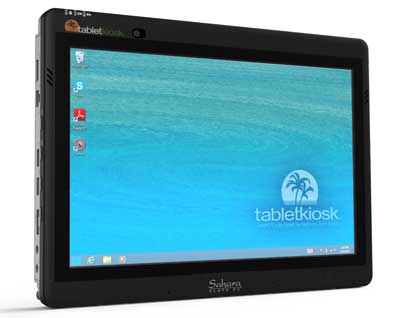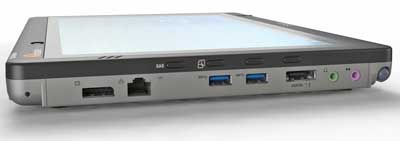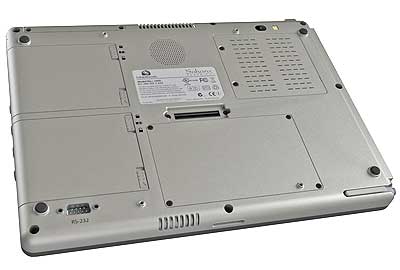

What does that mean for customers? We have not had hands-on with the new unit yet, but RuggedPCReview has benchmarked other products with the exact same Core i7-3517UE processor that powers the new Sahara i575, and so based on those results, here are our estimates of the performance users can expect from TabletKiosk's new top-of-the-line Sahara Slate PC i575:
| TabletKiosk Sahara new vs. old |
| PERFORMANCE COMPARISON | TabletKiosk | TabletKiosk |
| Model | i575 | i500 |
| Processor Type: Intel | Intel Core i7 | Intel Core i7 |
| Processor Model | 3517UE vPro | 640LE |
| CPU Speed | 1.70GHz | 2.0Hz |
| Turbo Speed | 2.80GHz | 2.80GHz |
| Thermal Design Power (TDP) | 17 watts | 25 watts |
| CPU Mark | est. 3,183 | 1,826 |
| 2D Graphics Mark | est. 477 | 297 |
| Memory Mark | est. 1,060 | 753 |
| Overall PassMark | est. 1,500 | 817 |
| CM ALU | est. 42,000 | 28,270 |
| CM FPU | est. 39,300 | 27,794 |
| CM MEM | est. 34,000 | 23,090 |
| CM D2D | est. 2,100 | 1,604 |
| CM OGL | est. 6,000 | 2,266 |
| Overall CrystalMark | est. 169,000 | 104,435 |
The new processor, of course, is only part of the story. TabletKiosk took this opportunity to improve the Sahara Slate PC not only on the CPU front, but in several other areas as well. Maximum RAM has doubled to 16GB, and as any Windows user knows, more RAM is always better. Maximum hard disk storage has doubled as well, to a full terabyte. That would have been unthinkable just a few short years ago, but now there are many scenarios where this much storage is almost mandatory. Those going with an SSD also have options up to 480GB.
Ancillary benefits of the switch to third generation Core processor technology include native USB 3.0 support, DDR3L support, and SATA III support. That, again, means more speed, higher performance, lower power. On the graphics side, while Intel began experimenting with integrated graphics in the initial generation of Core processors, it really wasn't until the "Ivy Bridge" third generation that everything fell into place, and the new Slate PC i575 benefits from that. We're still not talking the equivalent of a discrete third party graphics card, but quite close to it. And the DisplayPort video-out drives external monitor resolutions up to 2560 x 1600 pixel, and with cable lengths up to 50 feet.
As for the i535 Celeron-based version, it's a viable alternative. While Celeron processors used to be Intel's low-end and largely to be avoided, that has changed in recent processor generations. Celeron's are now based on the same lithography as Core processors, and often look like somewhat stripped versions of Core i3 chips, i.e. more than good enough for many applications. Like Core i3 chips, though, Celerons do not have the Turbo Boost feature, and other Intel technologies are missing, so customers should examine what they may or may not need. >For a side-by-side comparison of the two processors available in TabletKiosk's latest.
But there's more yet. When we examined an older Sahara i500 just a few months ago, we were a bit disappointed not to find any cameras. Well, TabletKiosk fixed that. The new i575 has a 2mp front camera from video conferencing, and a 5mp rear-camera for documentation, and that one can shoot full 1080p HD video.
And TabletKiosk thought of another seemingly little thing that may well matter in many applications: the new models have a true serial interface controller and DB9 serial port. While there are USB-to-serial converters, USB and serial are inherently different in the way they provide power (USB uses +5V, serial +5V, +12V, and -12V) and that can pose problems because converters may not support the voltages properly, and/or they may also not have the proper hardware flow control for a particular serial interface application. With a true serial controller, that's never an issue.
The picture below shows the backside of the i575 with its docking connector port in the center, the dual battery compartments, and the rear-camera with its LED illuminator.

One thing that certainly didn't have to be replaced in the i500 Series is the AFFS+ 12-inch display. It is large enough for real work, and it has a perfect viewing angle in all directions. It uses what TabletKiosk calls its SUNBRITE sunlight enhancement technology where a degree of sunlight reflection enhances screen brightness. The i500 we recently tested had that display and it was certainly very readable outdoors, and its semi-matte surface made for very little reflection.
What also continues is the wide range of available touch and digitizer technologies. Projected capacitive multi-touch is available for the Sahara. But customers can also order resistive touch. Or they may opt for a dual mode panel with an active Wacom pen and either projected capacitive touch or resisitive touch. And unlike many Windows tablets, there is no bulky bezel around the screen for fingers to bump into; the flush-mounted glass extends well beyond the perimeter of the LCD.
Overall, like they do with their smaller eo tablet, TabletKiosk covers a lot of ground with their newly enhanced Sahara platform. Not only is the Sahara available in a wide range of performance (and price) levels, but TabletKiosk future-proofs its products by upgrading them with state-of-the-art technologies as they come along.
As for pricing, the new i575 Intel Core i7-based model starts at US$2,149 (4GB RAM, 500GB HD), reasonable for this class of machine. If cost is an issue, the Celeron 1047UE-powered i535 version (2GB RAM, 320GB HD) starts at US$1,749.
From:http://www.ruggedpcreview.com/3_slates_tabletkiosk_sahara_i575.html
745TDBanty 130627
No comments:
Post a Comment